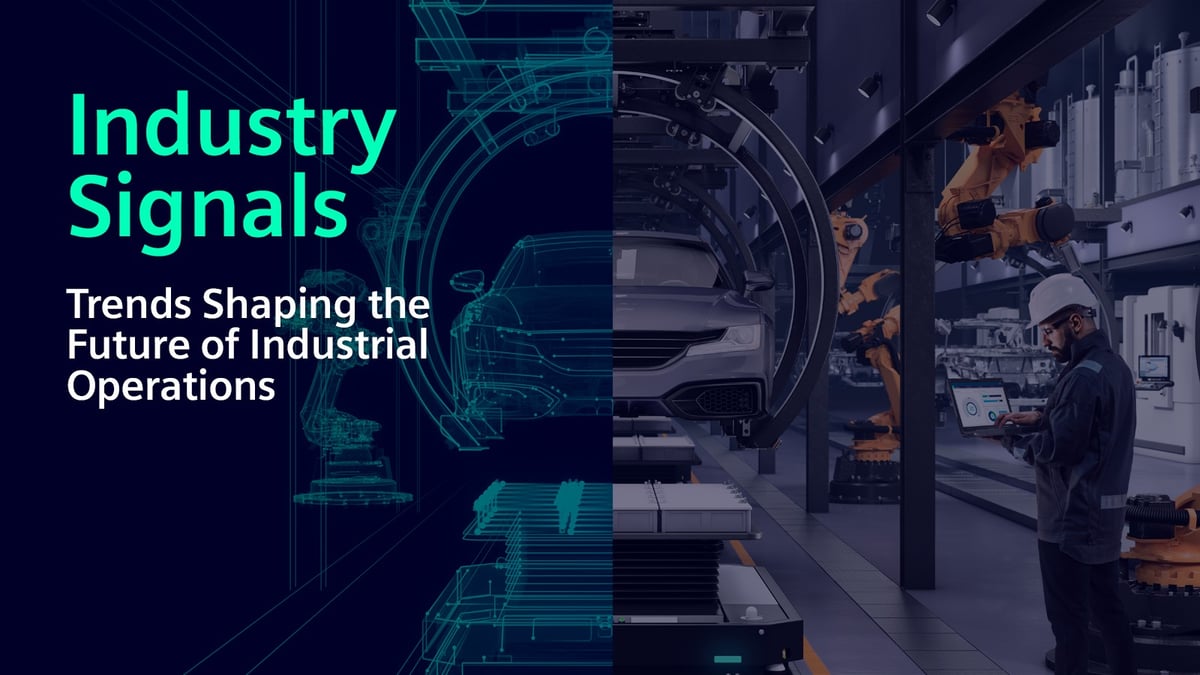Welcome to this week's edition of Industry Signals, where we're exploring transformative trends reshaping the landscape of industrial innovation.
This week, we focus on edge computing and artificial intelligence. We'll examine how seamless edge-to-cloud integration, robust zero-trust security frameworks, and data sovereignty are becoming indispensable for modern industrial operations, complemented by key insights from tech analyst Benedict Evans' latest presentation, "AI Eats the World," highlighting AI's profound impact on business models, infrastructure investments, and strategic innovation. Lastly, we'll explore the critical implications of EY's Reimagining Industry Futures Study 2025, outlining the integration complexities and ecosystem dynamics that industries face as they navigate the adoption of edge computing solutions.
Trends Impacting the Future of Edge Computing
Source: Xcelerator Community | Published: May 27, 2025
The edge computing landscape for industrial applications is rapidly evolving, driven by critical strategic trends that are reshaping how industries operate and innovate. These signals from the edge highlight the growing maturity and expanding capabilities of localized data processing.
1. Seamless Edge-to-Cloud Orchestration: The future of industrial operations hinges on the smooth flow of data and control between edge devices and the cloud. Edge-to-cloud orchestration is becoming indispensable, providing a unified management plane for deploying, monitoring, and updating applications across distributed industrial environments. This ensures data consistency, scalability, and streamlined operations, maximizing the value derived from edge deployments.
2. Bolstering Security with Zero Trust at the Edge: As more devices connect at the edge, the attack surface expands. This necessitates a robust security paradigm. Zero-Trust security principles are increasingly critical, assuming no device or user can be inherently trusted. Every access attempt, regardless of origin, requires stringent verification. Implementing Zero Trust at the edge—through micro-segmentation and continuous authentication—is vital for protecting sensitive operational data and critical infrastructure from cyber threats.
3. Navigating Data Sovereignty and Regulatory Compliance: The vast amounts of data processed at the edge bring data sovereignty and regulatory compliance to the forefront. Edge computing offers a solution by enabling local data processing, reducing the need for cross-border data transfers, and simplifying adherence to regional data protection regulations (e.g., GDPR). This localized approach is crucial for industries handling sensitive information and operating in diverse regulatory landscapes.
Insights from Leading Institutions:
- Gartner projects that by 2025, 75% of enterprise-generated data will be created and processed outside traditional data centers, underscoring the irreversible shift to the edge.
Please note: source report from 2023 is behind a paywall
- The World Economic Forum (WEF) highlights the increasing role of AI Agents in Industrial Operations, a trend significantly enabled by edge computing's ability to process data locally and in real-time.
- IDC's "Worldwide Semiannual Edge Spending Guide" consistently forecasts significant spending on edge computing, reflecting its growing importance across various industries. IDC emphasizes that enterprises are heavily investing in edge infrastructure and applications to support real-time data processing and intelligent automation.
These strategic trends underscore that edge computing is not just a technological upgrade for industry but a fundamental shift towards more intelligent, secure, and compliant industrial operations.
AI is Eating the World - Analyst Benedict Evans' Latest Presentation
Source: Benedict Evans | Published: May 2025
Each year, analyst Benedict Evans delivers a landmark presentation on the state of the technology industry. His 2025 edition, AI Eats the World, explores how artificial intelligence is transforming platforms, infrastructure, and strategy across sectors. Below are five of the most compelling insights from the presentation, each illustrated by a key slide: - A New Platform Shift Is Underway
Evans outlines how the tech industry experiences a major platform transition roughly every 10 to 15 years, from PCs to the web to smartphones. AI is now driving the next transition, but its shape, dominant interface, and user model are still uncertain. We are in a “pre-iPhone” moment, filled with potential but lacking clarity on what the breakthrough use case or form factor will be (Slide 12).
- Capital Investment Is Surging and Fragile
There is a dramatic rise in capital expenditures from Big Tech companies as they build out AI infrastructure. At the same time, the large language model may be the fastest depreciating asset in tech history. Each generation becomes obsolete within months, creating a high-risk scenario where infrastructure cycles and model lifespans are deeply misaligned (Slides 25 and 31).
- Big Tech Is Asking: How Do We Use This?
Tech giants are each taking distinct strategic approaches to AI. Microsoft is embedding copilots into its software suite, Google is rethinking core search functions, and Meta is promoting open-source models. The central question is no longer whether to build AI but how to apply it meaningfully across business functions (Slide 33).
- Disruption Comes in Different Forms
Evans presents a valuable comparison: Uber disrupted and diminished the traditional taxi market, while Airbnb has grown alongside hotels rather than replacing them. AI may follow both patterns. Some industries will be eroded, while others could be extended or reinvented. Understanding the type of disruption is key to navigating its impact (Slide 38).
- AI Is Touching Every Function
Every department, from legal and marketing to engineering and finance, is now running AI pilots. This shift marks a move from isolated experimentation to widespread integration, signaling that AI is rapidly becoming a foundational capability across the enterprise (Slide 41).
Evans closes the presentation with a quote from Steve Jobs: “What’s happening in the computer industry is that things are changing… and the people who are doing the work are becoming more important than the tools.” As this new platform takes shape, the advantage will go to those who embrace learning, iteration, and collaboration in the face of fast-moving change.
EY Reimagining Industry Futures Study: Edge Computing Implications
The EY Reimagining Industry Futures Study 2025 provides critical insights into how edge computing, combined with other emerging technologies such as 5G and AI, is shaping industrial operations. The study underscores the complexities and opportunities businesses face as they advance their technology agendas. Three major implications for industries adopting edge computing are highlighted below:
- Integration Complexity and Scalability Challenges:
Although edge computing ranks third among emerging technologies in active deployments, its adoption remains limited, with only 22% of enterprises actively deploying it. Organizations cite integration complexity (48%) and budget constraints (46%) as primary barriers. Industries such as consumer goods and automotive report particularly acute challenges with technology integration, emphasizing the need for vendor support to simplify deployments and facilitate scaling (pages 12-13).
- Critical Yet Underestimated Role in AI and 5G Integration:
Edge computing's pivotal role as an enabler for low-latency AI applications has seen a surprising decline in perceived importance. Only 42% of businesses currently recognize edge computing as complementary to digital connectivity strategies, down from previous years. This indicates a significant awareness gap that needs to be bridged through targeted educational efforts, particularly as enterprises increasingly seek the combined capabilities of AI, 5G, and IoT to enhance real-time operations and analytics (pages 24-25).
- Emerging Importance in Vendor Selection and Ecosystem Participation:
Enterprises increasingly prefer vendors that can effectively orchestrate ecosystems and deliver integrated, scalable technology solutions. Edge computing solutions must not only address performance and security concerns but also support enterprises' sustainability objectives, which are now integral to technology investment decisions for 87% of businesses surveyed. Vendors able to clearly articulate edge computing’s role in these integrated ecosystems will have a significant competitive advantage, given the growing trend toward supplier consolidation (pages 28-30, 38).
As industrial enterprises strive to convert edge computing trials into enterprise-wide deployments, addressing integration challenges, improving technology awareness, and strengthening vendor ecosystems will be critical to unlocking edge computing's full potential.
That's this week's edition of Industry Signals.
Have a story, report, or event that you would like featured in an upcoming issue? Feel free to reach out via PM!
Industry Signals Community Editor











